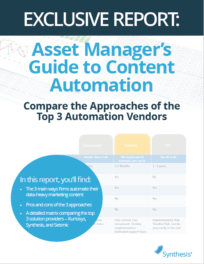Account-Based Marketing for Investment Management Marketers
The following is a guest post by Candyce Edelen, CEO of PropelGrowth Financial Marketing & Content Strategy. This post originally appeared on the Propel Growth blog.

Account-based marketing (ABM) can be a powerful marketing strategy for the investment management or asset management industry. This is particularly true when investment managers target institutional investors or sell through intermediaries. Both of these client bases have complex decision processes that involve a number of influencers. Account-based marketing approaches can help investment management marketers improve marketing ROI and have a more direct influence on revenue.
Insights from our Investment Management Marketing Round Table
We discussed this issue at a recent round table hosted by Synthesis Technology and PropelGrowth.
This was our second annual investment management marketing roundtable. The full-day event was attended by senior marketers from 15 different investment management firms ranging from $20B to $2T in assets under management (AUM). We discussed a range of topics including:
- Client-centric vs. investment-centric marketing strategies
- Account-based strategies for growth and retention
- How the industry can improve marketing and sales effectiveness
I wrote up a report on the round table that you can download here.
Account-Based Marketing is a New Frontier for Investment Managers
During the event, I asked who at the table is using account-based marketing (ABM). Only 1 of the 15 participants was familiar with the term, and none had experimented with the strategy.
The investment management space tends to lag behind other industries in its adoption of modern marketing techniques. So I was not really surprised to find that most of the participants were unfamiliar with the term and the concept.
What is Account-Based Marketing?
In most cases, investment management marketing focuses on individuals within target firms. They measure campaign effectiveness based on individual engagement
But in intermediaries, institutions, and even medium or large independent advisories, individuals don’t make decisions in isolation. They’re part of teams, and multiple decision-makers are involved in the process.
Account-based marketing is a B2B strategy that concentrates sales and marketing resources on a clearly defined set of target accounts within a market and employs personalized campaigns designed to resonate with each account. Instead of targeting individuals and tracking leads, ABM targets buying teams within an account and tracks overall account engagement.
Account-based marketing essentially leverages and supports strategies long used by Sales for targeting strategic or enterprise accounts. It’s a highly customer-centric method to gain access, generate opportunities, and expand reach in key accounts.
Account-Based Strategies Deliver Better Results
The analyst firm TOPO researches the effectiveness of account-based strategies. They report that firms using an account-based focus are seeing a 171% uplift in revenue within target accounts. While TOPO’s research primarily focuses on the technology industry, the model would work equally well with both institutional investor and intermediary targets.
ABM works best if it’s executed as a series of plays over time targeting a group of people in the key account. To implement an ABM approach, the investment management marketer and sales person/wholesaler should work together in lock-step.
Learn more about ABM:
What is an Account-Based Strategy?
Is Account-Based Marketing Right for Our Firm?
Who Investment Managers Should Target for ABM Strategies
Account selection is a critical element of an ABM strategy. ABM is resource-intensive and demands significantly more personalization and customized marketing messaging. So to deliver an ROI, the target accounts need to be strategically selected. ABM is more expensive on a per/account basis, but 97% of firms that apply it say they get a better ROI from these methods (according to research by AlterraGroup).
During our Round Table, the group came up with several types of accounts they could effectively target with ABM strategies. Here are their ideas:
Target Slightly Outside Your Top 20% Producers
Most investment management sales teams find that 20% of their clients produce 80% of the revenue every year. Consequently, sales tends to focus most of their efforts on these top producers. The round table participants described the remaining 80% as “dabblers.” But volume doesn’t drop off a cliff after the top 20%. Every firm has plenty of “dabblers” who drop a ticket or two now and then. These are relationships that could be nurtured and eventually move up to refresh or grow the top 20%. So consider targeting the next 5-10% of your producers.
Key “Focus Firms”
Every asset manager has a top-ten list of target institutions where your firm currently lacks significant coverage. This might include your key “Focus Firms.” In many cases, these accounts are owned (and guarded) by national account managers. This is a great place to begin collaborating with a very account-focused sales team.
Wirehouse Financial Advisor Teams
Another participant suggested looking at advisor teams within a large wirehouse. Marketing and sales can identify the account teams that are doing substantial business with you, and then find other teams within the account that look like your key performers. This is particularly helpful when your firm is limited in what you can communicate to advisors within intermediaries. Taking an account-based approach allows you to create custom content that fits inside the parameters set by that account’s compliance department. Then you can copy the approach and customize it for another wirehouse.
IBD Advisor Teams
You could use this same approach with independent broker dealers (IBDs). Start by identifying the top 5 performers or teams in an independent broker firm like LPL, and then look for other advisors within LPL that match those criteria. As with the wirehouse example, you will probably need to work with the intermediary to develop programs acceptable to their compliance teams.
Key Account Expansion Opportunities
Another strategy is to focus on key institutional customers or advisor groups that represent good expansion opportunities. For example, maybe you get orders from a small slice of advisors at a given firm, but your coverage with the rest of the advisors in that firm is thin. Or you may get orders for one or two products from an institution, but no tickets for most of your fund portfolio. Consider developing campaigns for these specific accounts that help expand your coverage.
ABM Requires a Team-Based Approach
In the typical (non-ABM) approach, Marketing sources a lead, nurtures it with content, monitors responses, and then passes it to Sales when the lead reaches a pre-determined threshold. Leads are almost always individuals rather than accounts or teams. Once the lead is passed on, Sales takes over, and Marketing rarely gets a view into how the lead is managed. This is particularly true in the investment management industry, where marketing rarely has access to the account and opportunity applications in their CRM.
In an ABM world, the marketer and sales person should be working together in lock-step to target an account. ABM works best if it’s executed as a series of plays over time targeting a group of people in the key account.
In this approach, Sales and marketing work together to select accounts, come up with a strategy and content topics to target that account, collaborate on the campaign development and on execution.
ABM only works in a closed loop where Marketing and Sales both have visibility into the interactions and results. For example, Sales needs to know who’s responding to Marketing touches, and Marketing needs to know what kind of response Sales is getting. Then they need to collaboratively tweak the strategy as they go, to enhance effectiveness.
Sample ABM Playbook
Here’s an example of how an investment management ABM playbook might look for a given campaign:
- Marketing and Sales research the target account to identify likely needs and collaboratively come up with a campaign approach that involves articles and an event.
- Marketing develops content and plans an event customized for the specific account (content and event topics should be related).
- Sales determines who in the account they should target, and identifies the appropriate leads in the CRM. If there are missing contacts for that account, Marketing helps obtain contact information.
- Someone (possibly marketing or sales operations) updates the CRM to ensure that all the relevant leads are connected to the appropriate accounts and made accessible to Marketing for executing automated campaigns.
- Marketing emails all the relevant contacts in the account, offering the content developed in Step 2.
- Sales calls each of the contacts in this account trying to get a meeting to discuss the content.
- Marketing sends print and email invitations for the event, accompanied with a way for the recipient to RSVP.
- Sales calls RSVPs to reconfirm and non-responders to reinforce the invitation and secure more RSVPs (thus starting a conversation).
- At the event, Sales meets the people in that account, establishing relationships and starting conversations.
- After the event, Marketing sends follow-up content (from the sales person) with a call to action encouraging a follow-up meeting with the sales person.
- Sales follows up with a call to discuss the topic of the content Marketing sent out.
This approach allows Marketing and Sales to work together on a concentrated campaign targeting a specific account. The idea is to establish a surge of activity across all the account stakeholders, creating an opportunity for engagement across the account.
Research into the effectiveness of account-based techniques has found that senior executives are 2.5X as likely to respond to a coordinated, multi-touch campaign.
To Maximize Effectiveness, Focus ABM on Existing Relationships
Marketers across the investment management industry are optimizing their strategies to make the most impact to revenue. To do this, they focus heavily on driving more revenue from existing relationships with intermediaries, advisors and institutional accounts. Account-based strategies are ideal for this effort and promise to deliver a more significant ROI than traditional mass marketing methods.
Reporting for ABM
Reporting is likely to be the biggest challenge faced by marketers experimenting with ABM. Marketing automation and CRM systems don’t handle an account-based focus well. They tend to focus at the individual lead level, tracking activity and scoring based on that individual’s behavior, not based on how that behavior fits with the broader organization that he or she is part of. So marketers who are looking to implement ABM strategies will have to work around these shortcomings. There are a number of tools that integrate with CRM and marketing automation systems help support the ABM approach. But many marketers are exporting data into Excel and analyzing account activity manually. This works in the beginning, and is the recommended approach for getting started with ABM. Later, you’ll want to use tools to help automate.
In addition, most of the asset management marketers at the round table are struggling with significant limitations in their CRM systems that will inhibit their ability to measure account engagement. I’ll write more about this in a future post. But manual tracking methods at the beginning will help marketers make a case for needing more visibility and reporting functionality in the CRM.
Get the Round Table Report
To learn more about the findings of our Investment Management Marketing Round Table, click here to download the report. If you’d like to be considered as a panelist for next year’s event, click here to register. (Note: Attendance is restricted to senior marketers in asset management firms.)
Here are some related resources that might interest you: From the Blog: Is Account Based Marketing Right for Your Company? |  From the Blog: 7 Problems With Automating Factsheets In PowerPoint |  From the Blog: Pitchbook Problems? 3 Ways Technology Can Help |




 Compare the Top 3 Finserv Content Automation Vendors [White paper]
Compare the Top 3 Finserv Content Automation Vendors [White paper] Create Pitchbooks the Drive Sales [White paper]
Create Pitchbooks the Drive Sales [White paper] Build vs. Buy: Should Your Financial Services Firm Outsource or Insource Marketing Technology? [White paper]
Build vs. Buy: Should Your Financial Services Firm Outsource or Insource Marketing Technology? [White paper]  10 Tips for Rebranding your Fund Marketing Documents [White paper]
10 Tips for Rebranding your Fund Marketing Documents [White paper]



